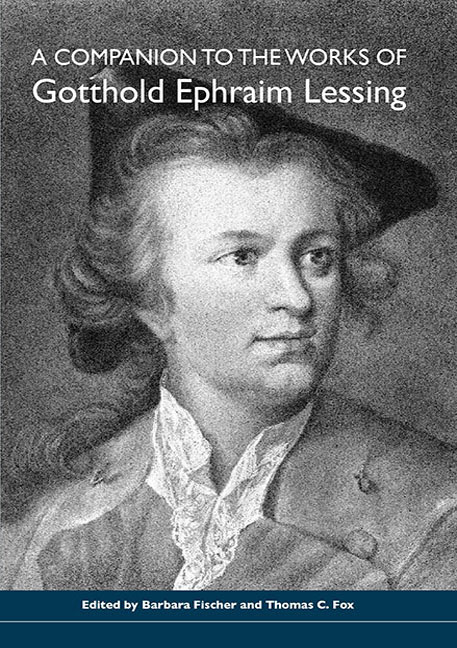Book contents
- Frontmatter
- Contents
- List of Illustrations
- Acknowledgments
- Lessing Editions and Abbreviations
- Selected Works by Lessing
- Introduction
- Lessing's Life, Work, and Times
- Criticism and Aesthetics
- Lessing the Critic: Polemics as Enlightenment
- Lessing and the Fable
- Lessing's Poetics as an Approach to Aesthetics
- Philosophy and Theology
- Drama and Drama Theory
- Reception
- Contact Organizations
- Works Cited
- Notes on the Contributors
- Index
Lessing's Poetics as an Approach to Aesthetics
from Criticism and Aesthetics
Published online by Cambridge University Press: 28 April 2017
- Frontmatter
- Contents
- List of Illustrations
- Acknowledgments
- Lessing Editions and Abbreviations
- Selected Works by Lessing
- Introduction
- Lessing's Life, Work, and Times
- Criticism and Aesthetics
- Lessing the Critic: Polemics as Enlightenment
- Lessing and the Fable
- Lessing's Poetics as an Approach to Aesthetics
- Philosophy and Theology
- Drama and Drama Theory
- Reception
- Contact Organizations
- Works Cited
- Notes on the Contributors
- Index
Summary
Dasjenige aber nur allein ist fruchtbar, was der Einbildungskraft freies Spiel läßt. Je mehr wir sehen, desto mehr müssen wir hinzu denken können.
— Lessing, LaokoonIn 1766 LESSING published his treatise Laokoon: Oder über die Grenzen der Malerei und Poesie (Laocoön: Or on the Limits of Painting and the Poetic Arts). It discussed the famous statue in the Vatican collection depicting the Trojan Priest of Apollo, Laocoön, and his two sons, in the process of being attacked by snakes. The story was popular in Classical times, existing in at least three separate versions, the most familiar being that of Vergil in the Aeneid (Book II: 13–249). The statue was discovered in 1506 just outside of Rome and then installed by Pope Julius II in the Belvedere Courtyard of the Vatican, where it remains today. There it was seen by Johann Joachim Winckelmann (1717–68) during a visit to Rome in 1760. His response to the statue is found in Gedanken über die Nachahmung Griechischer Werke in Malerei und Skulptur (1755, Thoughts on the Imitation of Greek Works in Painting and Sculpture). This work raised a number of issues which would continue to be debated for the rest of the century, with Goethe entering the fray in 1798.
In 1757 Moses Mendelssohn (1729–86) published an essay which was to greatly influence Lessing. In this essay, “Betrachtungen über die Quellen und die Verbindungen der schönen Künste und Wissenschaften” (Reflections on the Sources and the Links between the Belles-Lettres and the Sciences), Mendelssohn raises the issue of the relationship between the visual and the verbal arts. Lessing followed this approach in his Laokoon,exploring the broad fields of art theory and what we would now call “aesthetics” through the lens of his own perspective as a writer and poet, making use of poetic language in drawing attention to the importance of imagination and silence as artistic devices. In his essay, which is composed of numerous dialogues and digressions, Lessing tries to comprehend the complexities of the various disciplines of art by focusing on “Poesie,” that is, the poetic art that he claims is at the center of all literary endeavor. It is through his concept of “Poesie” in his Laokoon that Lessing makes his contribution to art and art theoretical discussions that have continued down to the present.
- Type
- Chapter
- Information
- A Companion to the Works of Gotthold Ephraim Lessing , pp. 105 - 130Publisher: Boydell & BrewerPrint publication year: 2005



